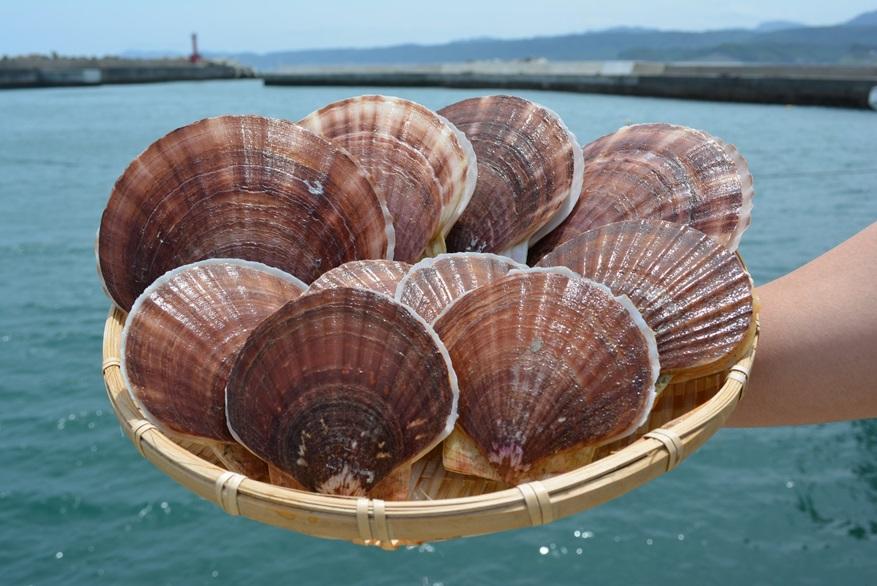Iwate Nodamura Araumi Hotate
| Registration Number | 47 |
|---|---|
| Name of the GI | Iwate Nodamura Araumi Hotate, Iwate Noda-mura Araumi Hotate |
| Class | Fish and Shellfish |
| Date of Protection | 2017/11/10 |
| Producing Area |
Iwate Prefecture
Noda Bay, Noda Village |
| Applicant - Name and Address | Noda Village Fishing Cooperative 27-73 Ōazanoda, Noda Village, Kunohe County, Iwate Prefecture |
"Iwate Nodamura Araumi Hotate" are scallops cultivated in Noda Bay in Iwate Prefecture in an environment with space allowing the scallops to swim freely and an abundance of plankton.
"Iwate Nodamura Araumi Hotate" are characterized by their meaty flesh. In particular, since cultivation at a low density allows them to swim around freely, their adductor muscles develop a firm texture and resilient elasticity. Further, their shells have a smooth and beautiful appearance because organisms that adhere to them are carefully removed.
As their taste, texture and appearance are superb and because they are delicious eaten raw, baked, grilled, boiled or steamed etc., their quality is highly regarded by restaurateurs etc.
"Iwate Nodamura Araumi Hotate" are farmed at Noda Bay off Noda Village in Iwate Prefecture.
"Iwate Nodamura Araumi Hotate" are raised from the larvae of scallops harvested from Noda Bay around April and May. After the larvae are caught using spawn collection tools and raised until around July or August, they are moved to cages for cultivation.
A characteristic of the farming of "Iwate Nodamura Araumi Hotate" is the emphasis on lowering the number of scallops per cage as they grow. By dispersing the scallops into multiple cages, an environment in which they can swim freely is maintained.
"Iwate Nodamura Araumi Hotate" are shipped to market from the year after spawn collection. By the time they grow large enough to be shipped, which is when their shell-length exceeds 11 cm, they will have been dispersed into fresh cages at least five times to facilitate their growth.
Organisms that have adhered to their shells are removed chiefly by machine, every time the scallops are dispersed and once again before they are shipped to market.
Noda Bay, where "Iwate Nodamura Araumi Hotate" are farmed, is located on the northern side of the Sanriku Coast of northern Iwate Prefecture. The northern part of Sanriku Coast is blessed with plentiful plankton and is nutrient-rich, where the cold waters of the Oyashio Current (1) flowing down from the north intersects with the warm waters of the northern branch of the Kuroshio Current (2) from the south and the Tsugaru Warm Current flowing down through the Tsugaru Strait (3).
Further, compared with other bays used for aquaculture, Noda Bay is characterized by relatively large open water. Thus, the regular inflow of fresh sea waters without stagnation contributes to maintain its clean water quality.
In these conditions favorable for aquaculture, producers cultivate scallops in cages to ensure that they can swim freely in a nutrient-rich environment. These conditions lead "Iwate Nodamura Araumi Hotate" to grow well and develop their highly regarded flesh and good taste.
Scallops farming in Noda Bay began with the nursery business in 1973. Producing scallops used for food began in parallel at the same time, with production increasing since the start of Heisei period.
Although the fisheries industry at Noda Village suffered catastrophic damage by tsunami in the Great East Japan Earthquake on March 11, 2011, local producers resumed spawn collection in May 2011, just after the earthquake.
- Oyashio Current: A subarctic ocean current that flows southward along Chishima Islands into east off Japan. It is also called Chishima Current. Its Japanese name can be translated as "parent current," signifying its role as a nutrient-rich current that nurtures marine life.
- Kuroshio Current: An ocean current that flows from the East China Sea past the Tokara Islands (a small archipelago between Kyushu and the Amami Islands) into the Pacific Ocean. It flows along the southern coast of the Japanese archipelago, then east off the Boso Peninsula. It is also known as the Japan Current. It is one of the largest ocean currents in the world, along with the Antarctic Circumpolar Current and the Gulf Stream in the Atlantic Ocean.
- Tsugaru Warm Current: A current flowing west to east through the Tsugaru Strait between Hokkaido and Aomori Prefecture. It is a branch of the Tsushima Warm Current that flows northward in the Sea of Japan.


